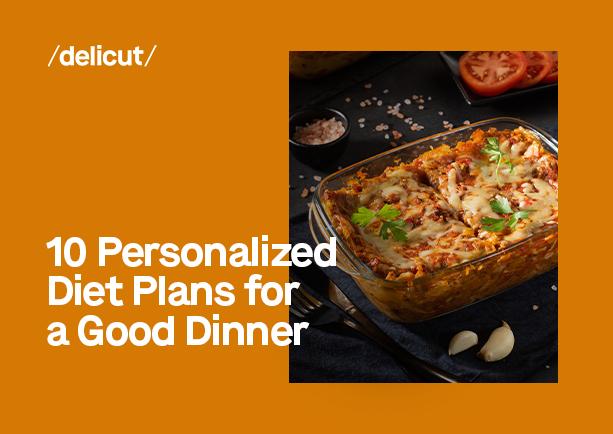10 Personalized Diet Plans for a Good Dinner

Dinner, a pivotal meal, is crucial in balancing our daily nutrition and health. However, with the myriad dietary needs and goals varying from person to person, a one-size-fits-all approach to dinner doesn't quite cut it.
Personalized diet plans tailored to individual requirements can make all the difference in achieving health objectives, whether it’s weight loss, muscle building, or managing a health condition.
We have curated a list of 10 personalized dinner diet plans, each designed to cater to specific dietary preferences and goals. From high-protein and low-carb options to vegan, Mediterranean, and diabetic-friendly meals, these plans offer a variety of choices to suit diverse nutritional needs.
1. High-Protein Diet Plan
Ideal for those looking to build muscle or lose weight, a high-protein dinner can be both satisfying and nutritionally rich. This diet plan incorporates protein sources like lean meats, fish, tofu, legumes, and dairy products. A typical high-protein dinner might include grilled chicken or salmon accompanied by a quinoa salad or steamed vegetables.
For vegetarians, a chickpea curry or a tofu stir-fry can provide ample protein. These meals aid in muscle repair and growth and help keep you full for longer, reducing the likelihood of late-night snacking. Incorporating various protein sources ensures a wide range of essential amino acids and nutrients, making your dinner both healthful and flavorful.
2. Low-Carb Diet Plan
A Low-Carb Diet Plan for dinner focuses on reducing carbohydrate intake while emphasizing proteins and healthy fats, making it a popular choice for weight loss and blood sugar management.
Ideal low-carb dinners include lean protein sources like grilled fish or chicken breast, paired with a generous serving of non-starchy vegetables like broccoli, spinach, or zucchini.
For a vegetarian twist, a salad with avocado, nuts, and a sprinkle of cheese offers a filling and nutritious meal. Meals such as cauliflower rice stir-fries or zucchini noodle pasta substitute high-carb ingredients with veggie alternatives, keeping the meal hearty without the extra carbs.
3. Vegan Diet Plan
The Vegan Diet Plan for dinner revolves around plant-based foods, excluding all animal products. It’s a great way to incorporate a variety of vegetables, legumes, grains, and fruits into your evening meal. A typical vegan dinner could be a hearty lentil soup, a vegetable stir-fry with tofu, or a chickpea and vegetable curry served with brown rice or quinoa.
These meals are rich in essential nutrients and high in fiber, which aids in digestion and satiety. Creative use of spices and herbs can add depth and richness to the dishes, making them flavorful and nutritious.
For those who enjoy experimenting, vegan versions of traditional dishes, like plant-based lasagna or stuffed bell peppers, can offer comfort and health benefits.
4. Mediterranean Diet Plan
This diet plan emphasizes fresh, whole foods typical of Mediterranean cuisine, known for its heart-healthy benefits. Dinners in this diet are rich in vegetables, fruits, whole grains, lean proteins, and healthy fats, particularly olive oil. A classic Mediterranean dinner might include grilled fish or seafood, a colorful salad drizzled with olive oil and lemon, and a side of whole-grain bread or couscous.
Another option could be a vegetable and bean stew flavored with herbs like rosemary and thyme. This diet encourages the use of fresh, seasonal ingredients and simple cooking methods to create meals that are both nutritious and delicious.
Rich in fiber, antioxidants, and good fats, Mediterranean-style dinners support overall health and are particularly beneficial for heart health.
5. Paleo Diet Plan
The Paleo Diet Plan is inspired by the eating habits of our Paleolithic ancestors, focusing on whole, unprocessed foods. Dinners following this plan typically include a lean protein source, such as grass-fed meat, poultry, or fish, alongside various fresh vegetables. For example, a Paleo dinner might feature a grilled steak or baked salmon, complemented by a side of roasted root vegetables and a green salad.
The exclusion of grains, legumes, dairy, and processed foods is a hallmark of this diet, steering the focus towards nutrient-dense, naturally occurring foods. This approach aids in weight management and supports overall health by minimizing processed ingredients and maximizing whole food intake.
6. Ketogenic Diet Plan
This high-fat, moderate-protein, and very low-carbohydrate approach has gained popularity for its potential in weight loss and energy enhancement. A typical ketogenic dinner focuses on healthy fats and proteins while keeping carbs to a minimum.
This could be a dish like a creamy avocado salad with grilled chicken, a salmon fillet with a side of sautéed spinach in olive oil, or a beef stir-fry with low-carb vegetables like zucchini or bell peppers. The key is to derive the bulk of calories from fats and proteins while limiting carbs to induce ketosis, a metabolic state where the body efficiently burns fat for energy. This diet plan is favored for promoting satiety and reducing appetite, aiding in weight management.
7. Gluten-Free Diet Plan
A Gluten-Free Diet Plan is essential for those with celiac disease or gluten sensitivity, focusing on meals free from wheat, barley, rye, and other gluten-containing grains. Dinners in this plan can be diverse and delicious, utilizing naturally gluten-free foods like rice, quinoa, potatoes, and various fruits and vegetables.
A typical gluten-free dinner might include a quinoa salad with grilled vegetables and a lean protein like chicken or fish or a hearty vegetable stew served over rice. Gluten-free pasta alternatives, such as those made from rice or legumes, also offer a satisfying option.
Emphasizing fresh, whole foods and avoiding processed gluten-free products ensures a nutritious and wholesome meal, catering to both health needs and taste preferences.
8. Low-FODMAP Diet Plan
This diet plan is designed to alleviate symptoms in individuals with irritable bowel syndrome (IBS) and other digestive disorders. This diet involves limiting foods high in certain fermentable carbs known as FODMAPs. A low-FODMAP dinner might include grilled chicken or fish with a side of low-FODMAP vegetables like carrots, eggplant, or spinach, and a serving of rice or quinoa.
Another option could be a FODMAP-friendly stir-fry using suitable vegetables and tofu or shrimp. Since onions and garlic are high in FODMAPs, alternatives like chives or the green tops of spring onions can be used for flavoring.
9. Diabetic-Friendly Diet Plan
This diet plan focuses on controlling blood sugar levels through balanced meals that combine fiber-rich carbohydrates, lean proteins, and healthy fats. For dinner, this might include a plate of grilled chicken or fish, a small portion of whole grain like brown rice or barley, and a side of mixed vegetables.
Another option is a bean-based chili or stew, packed with fiber and protein, served alongside a whole grain. Key to this diet is portion control and choosing carbs that have a low glycemic index to prevent spikes in blood sugar.
Including a variety of colorful vegetables and lean protein sources can make these dinners both nutritious and satisfying, catering to diabetic dietary needs without compromising on taste.
10. Vegetarian Diet Plan
The Vegetarian Diet Plan for dinner offers a plethora of nutritious and flavorful options, focusing on plant-based protein sources and a wide array of vegetables. A typical vegetarian dinner might include a lentil curry paired with brown rice, providing a complete protein and fiber-rich meal.
Alternatively, a stir-fry with tofu and an assortment of vegetables like bell peppers, broccoli, and snap peas, served over quinoa, offers a balanced and satisfying meal. For those who include dairy, a spinach and cheese stuffed pasta with a tomato-based sauce can be a delightful choice.
The key is to incorporate a variety of protein sources such as beans, lentils, tofu, and dairy (for lacto-vegetarians), along with plenty of vegetables and whole grains, to ensure a balanced and nutrient-rich diet.
Conclusion
Navigating through the myriad of dietary needs and preferences, these 10 personalized dinner plans offer a range of options to cater to various health goals and lifestyles. The key lies in understanding your body's requirements and choosing a diet that meets your nutritional needs and aligns with your taste preferences and lifestyle.
Remember, a well-planned dinner can significantly contribute to your overall health and well-being. Embrace the diversity of these diet plans and enjoy exploring the flavors and benefits they bring to your dinner table, all while staying true to your health goals.
FAQs
1. What is the best diet meal for dinner?
The best diet meal for dinner varies based on individual dietary goals, but a balanced dinner typically includes lean protein (like grilled chicken, fish, or plant-based alternatives), a portion of whole grains (such as quinoa or brown rice), and a variety of vegetables. This combination ensures a meal that is rich in nutrients, fiber, and protein, while being moderate in calories.
2. What is a personalized meal plan?
A personalized meal plan is a customized eating plan tailored to an individual's specific dietary needs, preferences, health goals, and lifestyle. It considers factors like age, weight, activity level, dietary restrictions, and health objectives (such as weight loss, muscle gain, or managing a medical condition) to create a meal plan that is unique to the individual.
3. What are some famous diet meal plans?
Some famous diet meal plans include the Mediterranean Diet (focused on fruits, vegetables, whole grains, and healthy fats), the Keto Diet (high in fat, low in carbs), the Paleo Diet (centered around whole foods and lean proteins), the Vegan Diet (excludes all animal products), and the Intermittent Fasting Diet (cycles between periods of fasting and eating).
4. What is an example of a balanced diet for dinner?
An example of a balanced diet for dinner could be grilled salmon (for protein and omega-3 fatty acids), a side of quinoa or brown rice (for complex carbohydrates and fiber), and a mix of steamed vegetables like broccoli, carrots, and bell peppers (for vitamins, minerals, and additional fiber). This meal offers a well-rounded nutritional profile with an appropriate balance of macronutrients.
Read More :
30 Day Paleo Diet Meal Plan Easy Recipes
5 Healthy Vegetarian Diet plan ideas
7 Day 1500 Calorie Meal Plan Ideas recipes
Related Blogs
Why do most people in the UAE get their calories wrong
Dec 8, 2025 | 6DASH Diet Meal Plan
Nov 11, 2025 | 8Fatty Liver Meal Plan
Oct 31, 2025 | 8Pregnancy Diet Meal Plan
Oct 27, 2025 | 82000 Calorie Meal Plan
Oct 1, 2025 | 8Intermittent Fasting Diet Plan
Sep 5, 2025 | 81000 Calorie Meal Plan
Sep 5, 2025 | 8High-Protein Meal Plans
Sep 5, 2025 | 8How to Choose the Right Meal Plan for Your Fitness Goals
Sep 5, 2025 | 8The GM diet plan: Is it possible to shed fat in just 7 days?
Sep 5, 2025 | 8






